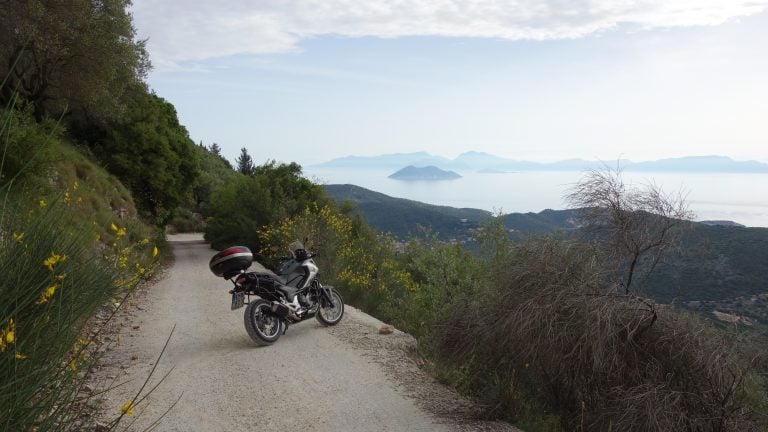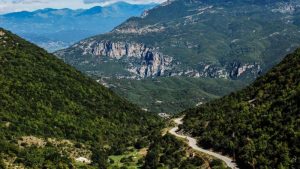The old Athens highway to Corinth is a refreshing ride on this warm morning in May. With the Mediterranean to my left and the mountains to my right, it feels good to be back motorcycling in Greece. I love this beautiful country, its rich history, and the ruins and mysteries I seem to discover around every corner in the road. I’ve come here to travel back in time every spring since I retired.
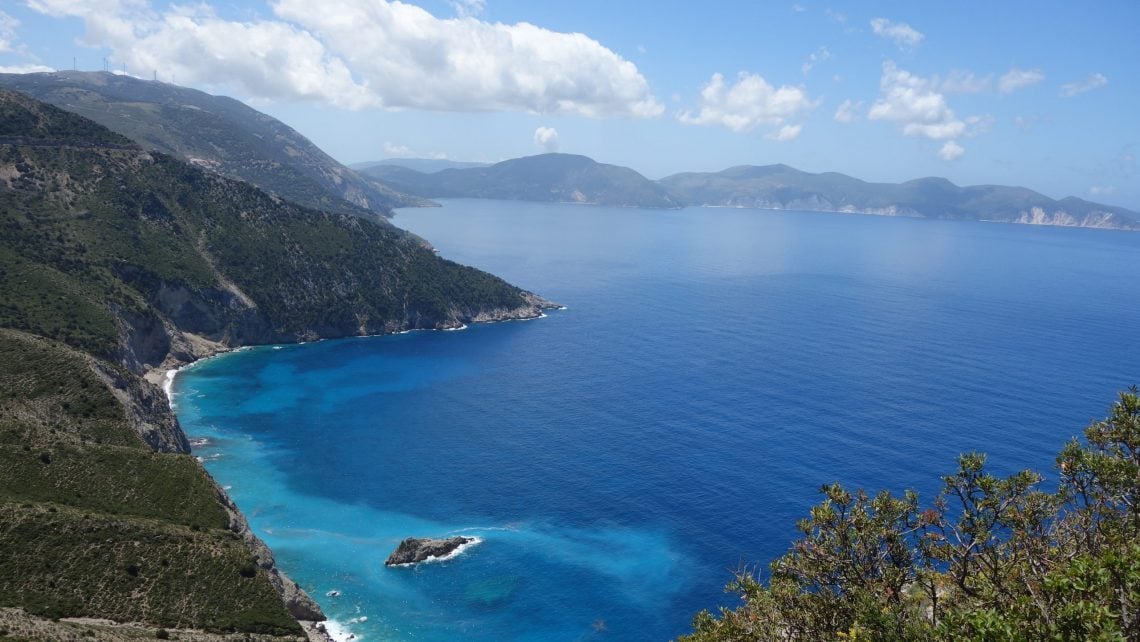
Land of legends
As I ride through the ancient coastal town of Megara, I look up into the mountains and imagine the place where legend says Theseus encountered the bandit Skiron, the murderer of innocent travellers. Skiron, of course, got some of his own medicine and ended up in the belly of a giant sea turtle somewhere nearby. I like to look beyond the natural beauty of these places and see the land as it once was, in its golden age, so steeped in its unrivalled mythology.
I’ll be riding into Corinth in another half hour and cross over the ancient canal into the Peloponnese wherein lies mountainous Laconia to the south. My ride there last year took me through the land of the Spartans and far to the south where the land ends at Cape Tenaro.
It was there that Hercules entered the netherworld kingdom of Hades to capture the three-headed dog, Cerberus, guardian of the gates to Hell. That southern land, called The Mani, was lonely and desolate, treeless and mountainous, and so beautiful. It was one of my best ever rides in Greece.
This time I’m on my way to visit the home of wily King Odysseus, hero of the Trojan War (Ulysses to the Romans). I’ll walk where he walked over three thousand years ago. Nothing compares to this trip. This is the culmination of all my Greek travels so far. Marathon, Delphi, Thermopylae, Olympia, places so rich in history, but they don’t hold a candle to the place I seek.
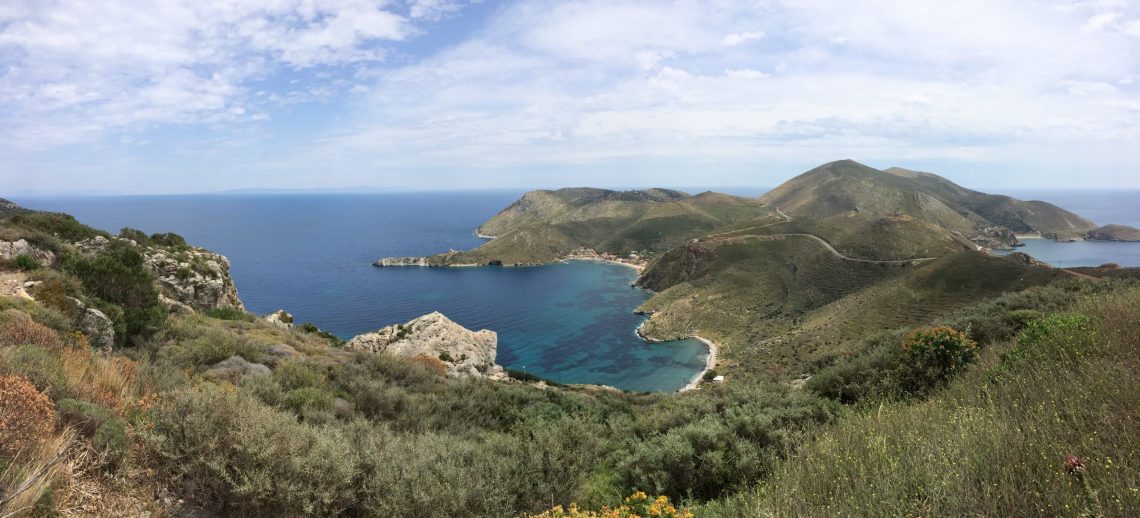
Beginning in Athens
I arrived from Canada two days ago and spent my nights in Athens at the Athens Backpackers Hostel. I was lucky enough to have a three-bed dorm room to myself which should have aided me in catching up on some sleep. It should have, but the beer and ouzo shots in the rooftop bar made for two late nights.
I love to stay at that place because I can meet other solo travellers from around the world. It beats staying in an expensive Athens hotel room alone and the hostel is located in the safest, cleanest part of Athens called the Plaka, just below the Acropolis. The Acropolis is lit up at night and under a full moon looks magical.
At 9am this morning, I picked up my rental bike. It’s a short 10-minute walk from the hostel to Moto rent on Kavalotti Street. Theodoros, the owner, has become my friend over the years and is always welcoming on my annual sojourn. For this trip I’d reserved a Honda instead of my usual BMW. He recommended it last year and I liked it, although I wasn’t too sure about it at first. It’s an NC750 twin.
Of all the bikes I’ve ridden in Greece, this one is the best. I’ve tried V-Stroms, Transalps and BMW 650 GSs, but this one is the most comfortable. It’s quite a little torquer and nimble enough in Athens traffic. It’s also got a small trunk where the gas tank should be where I can store my Bell Pit Boss helmet, and maybe a few beers. Oh, and it gets about 70mpg.
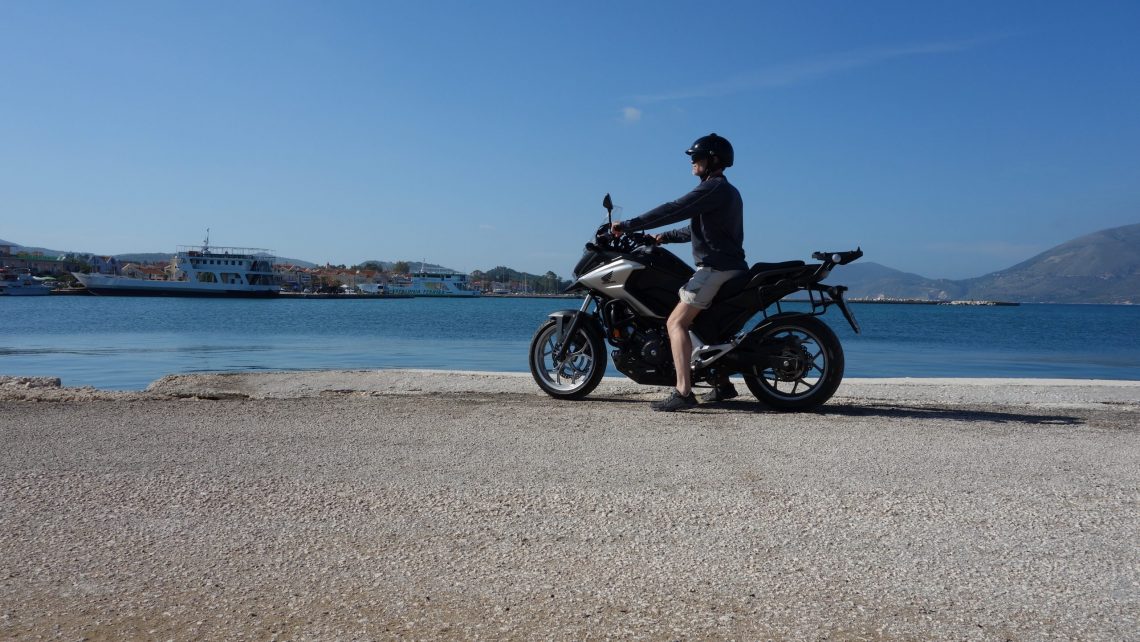
A learning curve
Now riding in Athens is a learning experience for North Americans who are used to certain riding etiquette. Forget about etiquette here, the rules of the road are just suggestions. There is plenty of filtering going on between lines of cars.
You need to keep your eyes on your mirrors or you will be gone in an instant as other bikes race to get to the front of vehicles waiting at a red light. I marvel at the scooter riders who hold a cigarette and a cellphone as they ride, or bags of groceries balanced somehow as they weave through traffic. Few wear helmets.
Once I’m out of the chaos that is Athens, I can put away the GPS and just cruise along, enjoying the warm sea breeze on my face. Once I’ve crossed the Corinth Canal, it’s a leisurely ride along the coast of the Gulf of Corinth. There are small villages with bleached white buildings, crystal clear waters and small inviting beaches at every turn.
I’m taking a ferry to an island off the west coast of Greece in the Ionian Sea. It is the largest of five Ionian islands. Kefalonia is known for its unmatched beaches, but also for the earthquake activity that has caused hardship there through the ages.
A quake in 1953 destroyed many of the island’s towns and caused a mass migration to the mainland. It still experiences many quakes each year, the most recent major one being in 2014. The neighbouring island of Zakynthos had a 6.4 quake just last year.
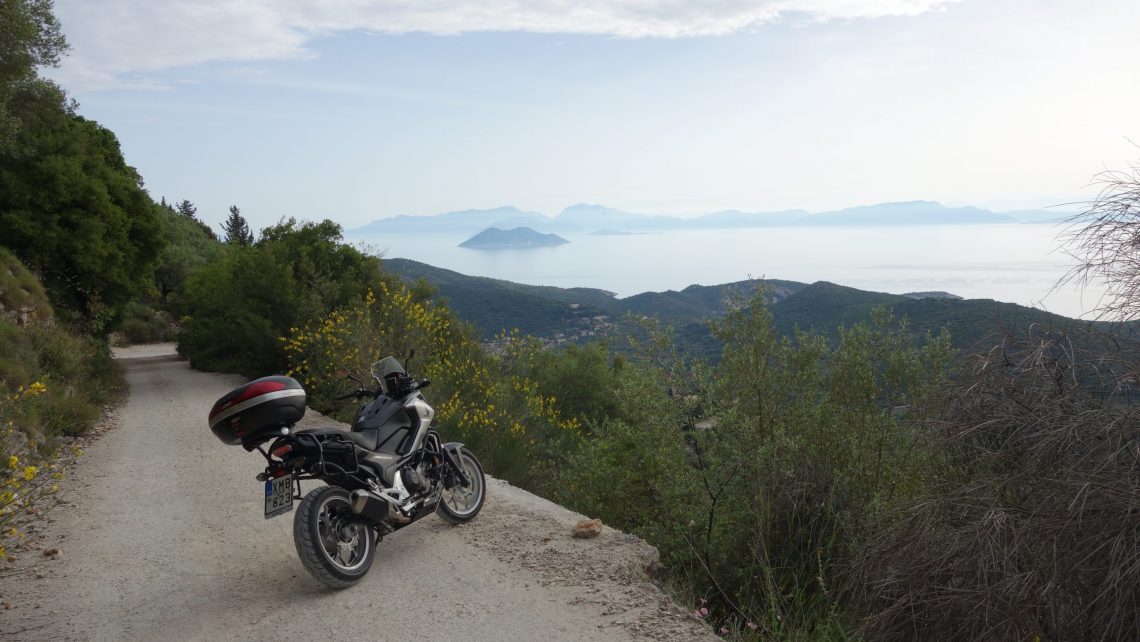
Good omens
I reach the ferry port of Patras around noon for my 1.30pm boat, the Andreas Kalvos. Patras is the third largest city in Greece and a very busy port. I find a small restaurant and enjoy a cold Mythos beer and a gyro wrap as I wait for the ferry. My ferry ticket is 35 Euro including the bike and it’s about a four-hour trip to the island. The sea is a picture of tranquility today against the manic pace of Patras’ traffic.
Once I’m onboard and the bike is secured, I toast the gods with another Mythos from the top deck. It was rainy and cold when I left Canada, so I won’t waste a day of sunshine outdoors. I never tire of just watching the calm blue sea and the misty distant coastline passing by.
I’m pleasantly surprised on this day by a good omen. I look up to see a natural anomaly, a ring around the sun. It’s a sign that says, “O for Odysseus”. I will soon be visiting his home and I’m getting anxious
The ferry lands at the little port town of Sami on the eastern side of Kefalonia and it’s about an hour from here to my destination of Lixouri on the western side of the island.
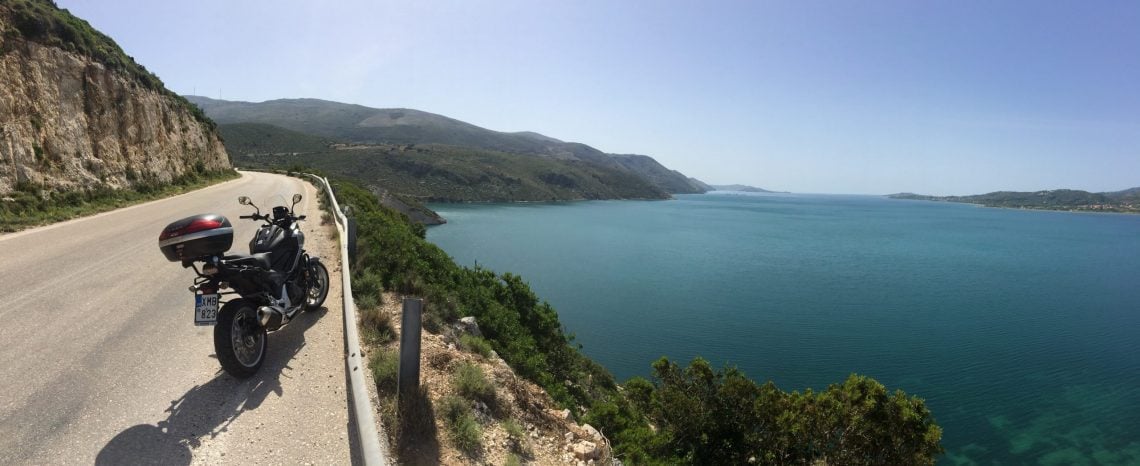
White knuckle riding
It’s a ride that takes me along the western coast of Kefalonia, past my favorite spot, Myrtos Beach. The road snakes along the mountainous coast, with precipitous drop offs to the ocean. Myrtos Beach is always among the top ten in the world and for good reason. It is a wild beach and not commercialised.
It’s a bit difficult to reach and not for the feint of heart if you’re a nervous driver. But on a motorcycle it’s a great ride down the winding little road full of broken pavement and switchbacks. I’m scared of heights so the absence of guardrails always gives me an extra shot of adrenaline.
Earthquakes have caused cracks in many roads on the island and minor rockfalls make night riding very dangerous. Around any blind turn there could be rocks on the road here or the goats that are everywhere. As with most roads in Greece, the pavement is shiny. Ride too fast with caution here because the goats are not what will take you down.
Downshifting into tight corners will cause you to fishtail on the slippery surface and any front braking will be quite dangerous downhill. If you’re unlucky enough to be mountain riding in the rain, you’d better go very, very slow. The scirocco wind out of Africa blows the Sahara dust here and it coats everything. I think that’s what adds to the slipperiness of these roads.
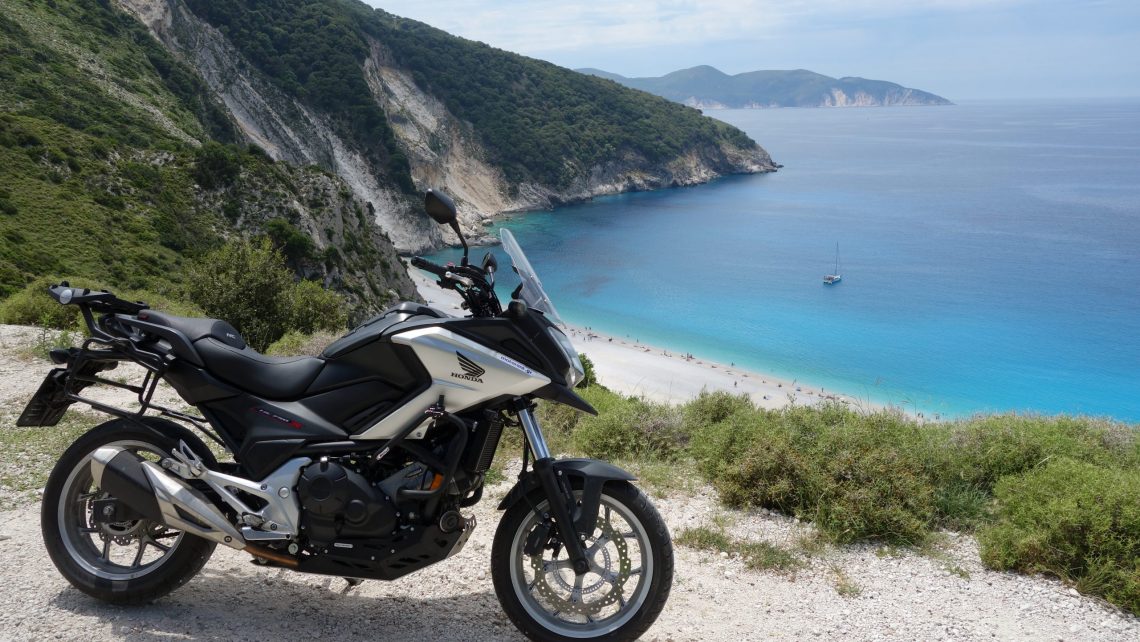
‘Ken is back! It’s beer o’clock!’
I arrive at my destination just outside Lixouri on the Bay of Livadi. It’s a small resort called Terra Mare. I love this place which I found by chance a few years back. In May it’s not busy yet and although it can accommodate hundreds. Last year, I was one of only five guests during my two-week stay.
I know I need no reservation here. The owner, Nicos, is like a brother to me and greets me with a big hug. “Ken is back! It’s beer o’clock!” he yells and a cold Mythos draft is in my hand before I even have my helmet off. God, I love this island.
Filoxenia, that’s Greek for hospitality, is hardwired into these descendants of Socrates. I never fail to feel welcomed here.
It’s late May, still off-season, perfect weather, no crowds, empty ferries, so an idyllic time to be here. I lay on a lounge chair beside an Olympic-sized pool watching swallows swoop down for quick drinks, and I gaze out at beautiful Livadi Bay as the sun descends behind the hills in the west. Tomorrow I will meet the person I’ve come so far to visit and the main reason I’ve come to love this island.
Three years ago, it was my good fortune to meet with a kindred spirit in Greece. But this was no ordinary Greek history buff. John Crawshaw is the coordinator of the very project that decoded the location of the mysterious lost island described by Homer in the Odyssey – the island of Ithaca, the home of King Odysseus.
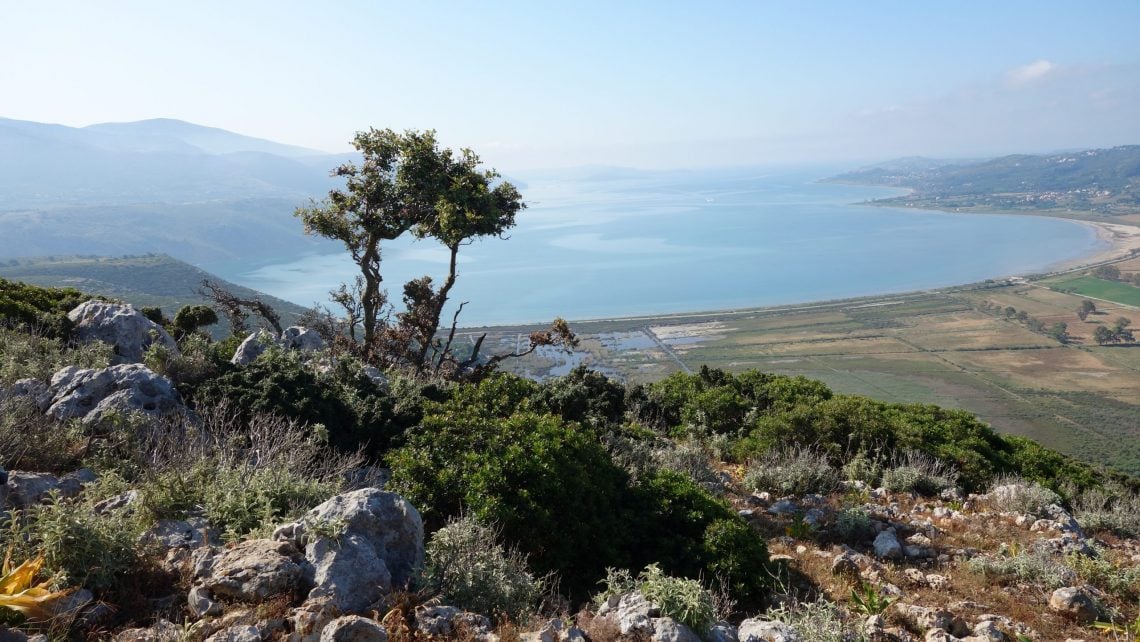
The Odyssey
The Odyssey is a story told of a hero’s journey home from the Trojan War. The story of this war was old when Jesus walked the earth. Gods and magic fill the pages of the epic tale which reads like The Lord of the Rings. This was a time when the descendants of the gods walked among men and heroes fought and died in bloody conflicts.
We know their names and their lineage, Hercules, Achilles, Ajax, Hector and so many others who are part of our everyday lexicon. The places named by Homer in The Iliad and its sequel, The Odyssey were determined by scholars to be as mythical as the gods and heroes themselves, but everything changed about a hundred years ago when they found Troy. It existed!
Then, they discovered the ruins of Mycenae. Then came Knossos. Then Tiryns. The story was true. The Trojan War did actually take place. To all the Greek classics experts it was like saying that The Lord of the Rings was a true story. They didn’t want to believe it but the evidence was irrefutable. There could be no debate about the reality of the war described by Homer.
But there has always been one place named in The Odyssey which eluded those who sought to rediscover it. It was the island of the greatest hero of the Trojan War. The island called Ithaca was not where Homer claimed it should be. It was a mystery for thousands of years up until the recently.
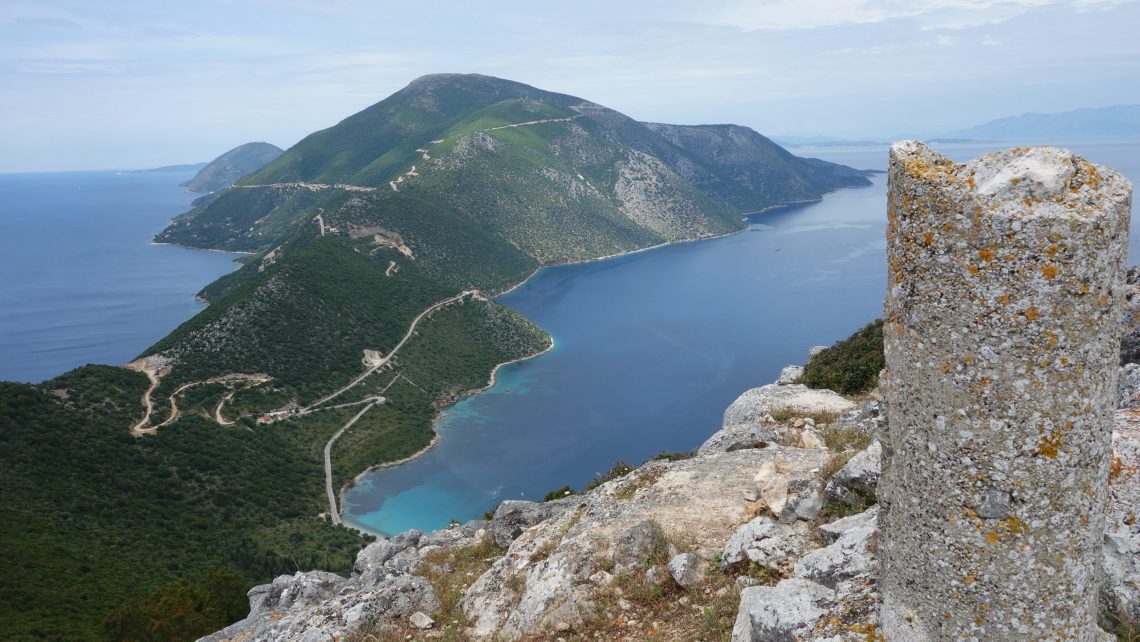
Finding Ithaca
Homer described Ithaca very precisely. He said it was ‘low lying’, ‘verdant’ and ‘last to see the sunset’ of the group of five Ionian islands. The modern island of Ithaca is none of these things. It is mountainous, rocky and the farthest east of the island group, not west where the sun sets. Thus, the mystery.
Something changed all that ten years ago. This island was found. It is the greatest discovery in modern Greek history in my opinion, thanks to a scholar named Robert Bittlestone. I’ve biked the modern island of Ithaca in the past and it is my favourite island for motorcycling. But it is not the true island of Ithaca.
There is a peninsula on the western part of the island of Kefalonia called Paliki. It has been proven to once have been separated from the rest of the island by a marine channel which was filled in by earthquake activity. Paliki fits Homer’s description of the rightful home of Odysseus. It is, in fact, the true island that Homer called Ithaca, home of the hero of the Trojan war.
The evidence provided by Bittlestone is incontrovertible for the true geographical location of the island. Paliki is also low lying and verdant with excellent fertile soil. He painstakingly followed Homer’s clues to identify other sites from the story and more evidence continues to be added each year. Political issues locally and national regulations have slowed the process but the end result will indeed have to mean a renaming of the current island of Ithaca to Doulicheon, its true ancient name according to Homer.
Terra Mare resort, where I now rest with a Mythos by the pool, lies mere miles from a hill named Kastelli and the ancient palace of King Odysseus where I’ll be taken by John Crawshaw in the morning. I am excited at the prospect.
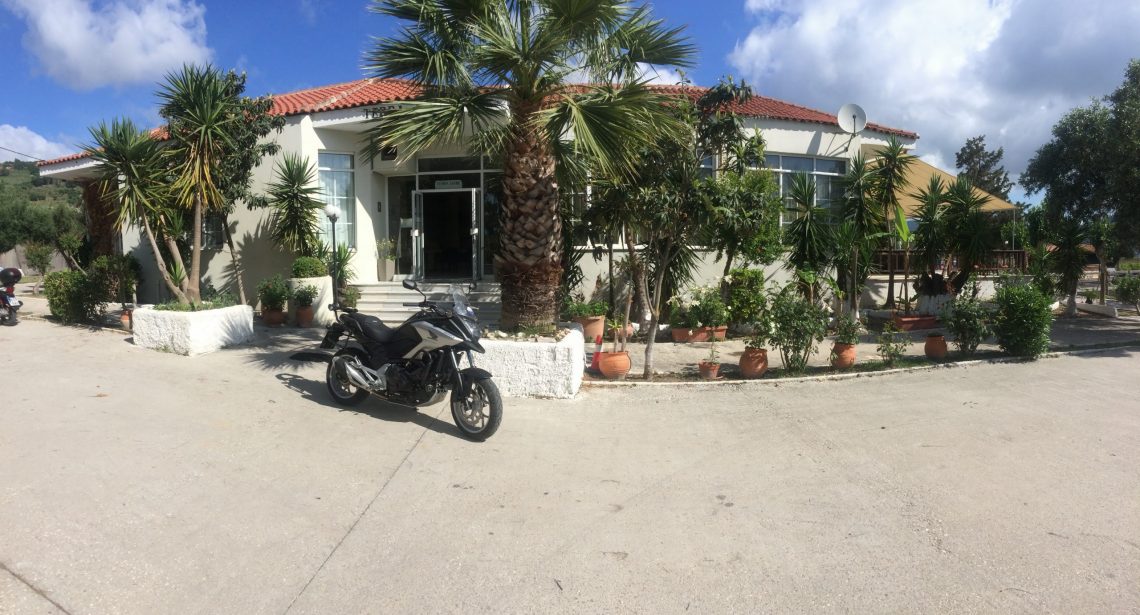
Woken by a judder
I’m not sure how long I slept but am awakened by a judder that goes through the place. Just one. I’m up and grabbing my helmet and backpack and heading outside where the stairway winds down to the rear gardens where my bike is parked. I stand on the stairs and wait for an aftershock. I wait for about ten minutes or so in complete silence outside.
Even the cicadas are silent. Finally, I go back to bed, but I keep my backpack and helmet close. In 2014, Nicos’s hotel lost all the clay roof tiles on this building during that serious quake, so I’m considering going down to move my bike farther away from the building. But I’m too tired to bother and finally fall asleep. This is a common occurrence on the island and the locals accept it. It’s my first experience and now I’m initiated.
In the morning, I ride up to nearby Kouvalata, a small village overlooking the island. On a clear day you can see the neighbouring island of Zakynthos from up there. This is where John Crawshaw has built a home. It is reinforced with lots of concrete and from its lofty height, has a bird’s eye view of the surrounding Paliki peninsula and many important sites relating to the Odyssey.
I understand why he chose this place at the epicentre of the greatest story ever told. This is his summer headquarters away from England and where he resides while the project he leads is in full swing.
He has taken me for tours before to important sites around this part of Paliki where ground penetrating radar has been making some very interesting discoveries. These discoveries must be cleared with officials in Athens before they can proceed and it’s a waiting game that takes time. But today I’m going to the top of the hill called Kastelli, to the place where the return of the ancient king resulted in a bloody massacre of a hundred men.
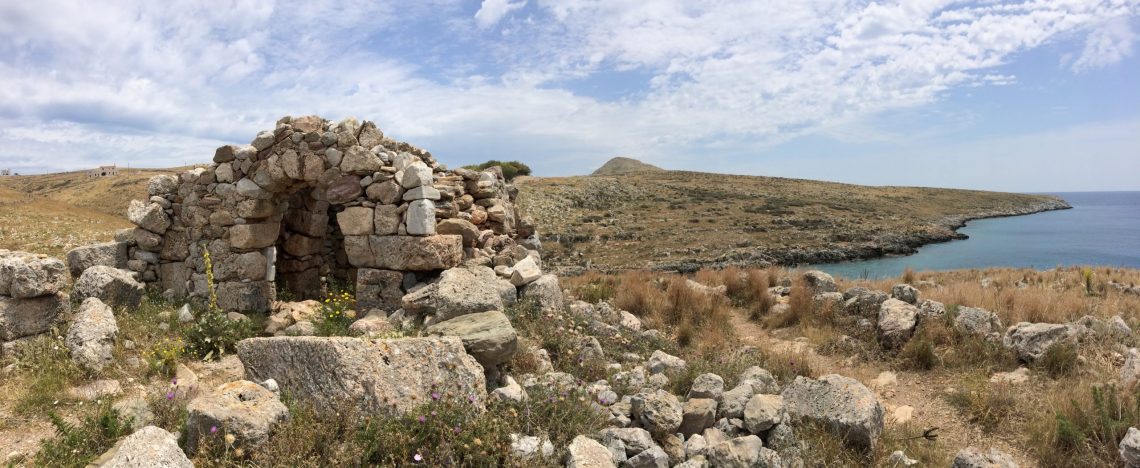
A hill called Kastelli
“Welcome back for your annual pilgrimage!” is my greeting when I arrive at the gate of John’s villa. Then within minutes we’re off in his 10-year-old Subaru Forrester. Badly in need of a new paint job it will never receive, this SUV has traveled literally every goat path and dirt road on Paliki in search of sites described in The Odyssey.
This trip is no different than others we’ve taken, up washed-out, rutted roads that my bike would have trouble navigating, and through farmers’ fields opening and closing crudely wired gates that keep the goats from escaping. And then we’re there, at the base of the hill Kastelli.
The nettles and thorny bushes tear clothing, so long trousers are a necessity even on this hot day. If it wasn’t for the narrow paths among the bushes made by local goats over hundreds of years, our half-hour hike up the mountainside would be more like a half a day’s journey.
But then I’m there. I’m standing where I’ve dreamed of standing when I was a kid. I’m at the very heart of The Odyssey. I stand where the hero of the Trojan war stood. I walk the ground where Homer’s epic tale began and ended. Soon, this place will be world news and lovers of Greek history will flock here. In a way, I hope it is not discovered by tourists and it remains a secret shared by a few. It’s so peaceful atop this magical place.
From here I look down on the ancient harbour below, now a shallow bay and marsh. But I see in my mind what once was a busy port below a palace with two towers. Potsherds (broken piece of ceramic material) scattered around the ground at my feet are pieces of that time 3,200 years ago. Somewhere on this peninsula lie the remains of that ancient king and the search will soon be on for his tomb. My hope is that it will be discovered before the grave robbers get to it. That’s the only thing that could ever top the honour I have been given on this day.
But for now, it’s time to honour John Crawshaw, my kindred spirit, with lunch and a Mythos.
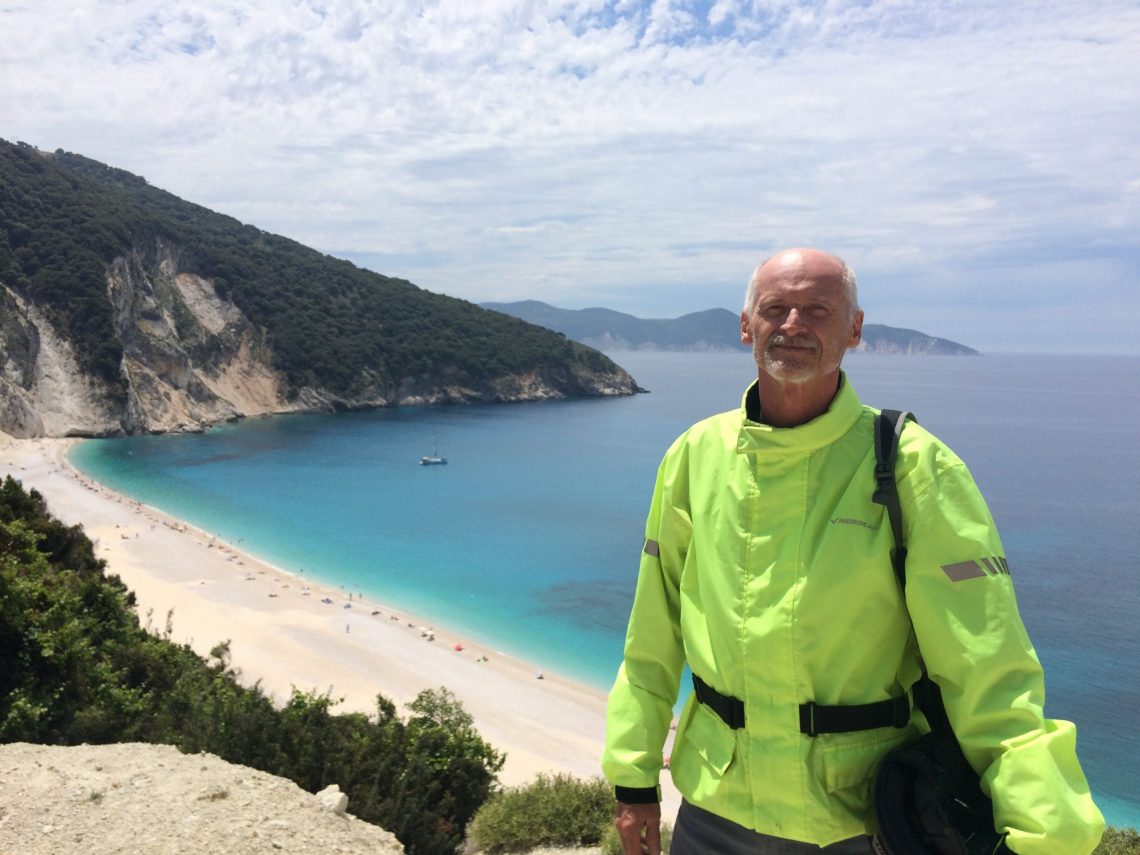
Who’s writing
Ken Gibson is an avid motorcycle enthusiast and freelance writer. From that first bike, a brand new 1972 Honda CB350 up to his current ride, a 1979 Kawasaki KZ1300, he’s been testing his abilities in all Maritime Canadian riding conditions over forty some years.
Retiring seven years ago opened the door to fulfilling a childhood dream of seeking out the Greek historic sites he read about as a child, but doing it on a motorcycle. You can find out more about Ken’s motorcycle adventures here.

